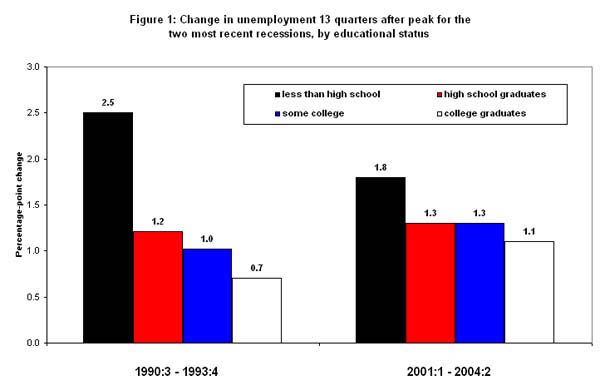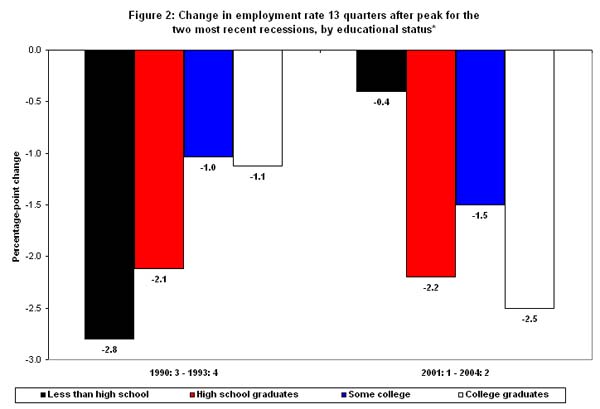See Snapshots Archive.
Snapshot for August 11, 2004
Current recovery blind to education attainment
When asked to testify on labor market problems in the current economy last March, Federal Reserve Chairman Alan Greenspan emphasized the importance of higher educational attainment. Unfortunately, higher education has not been providing the cushion against economic shocks that it once did.
Two economic indicators—unemployment and employment rates—provide insight into how fully people are engaged in the U.S. economy. These data, which can be broken down by educational status, provide an interesting insight.
Figure 1 shows that, 13 quarters into the early 1990s recovery, unemployment increased for all educational levels, especially for those with less than a high school degree, who saw a 2.5 percentage-point increase in unemployment. This increase was significantly larger than the increases for the three other educational levels examined in Figure 1.

Source: Authors’ analysis of BLS data
In contrast, 13 quarters into the current recovery shows a different scenario. Increases in unemployment by educational attainment are more uniform, signaling that this weak recovery has traversed across all educational lines. While the increase was still greatest among those with less than a high school degree, similar increases occurred for all other educational levels (ranging from 1.1 to 1.3 percentage-points). Especially unusual is the significant increase in the unemployment rate for college graduates—a 1.1 percentage-point rise in unemployment that exceeds the 0.7 percentage-point rise in a comparable period in the early 1990s.
Unemployment rates are informative, but they do have shortcomings. For example, not included in the unemployment rate are persons who, because of the lack of job prospects, gave up looking for work altogether. Therefore, employment rates—the ratio of employment to population—are a standard measure of labor demand that offers additional insight into the labor market. A look into employment rates (Figure 2) reinforces the notion that college-educated workers, especially after the 2001 recession, have become more vulnerable to weak labor markets. In fact, following the 2001 recession, employment rates for college-educated workers fell 2.5 percentage-points compared to the 1.1 percentage-point decline 13 quarters into the early 1990s recovery. Conversely, the decline in the employment rate for those with less than a high school degree was 2.8 percentage-points in 1990 and just -0.4 percentage-points since the latest downturn in 2001.

Source: Authors’ analysis of BLS data
* Seasonally adjusted data. EPI seasonally adjusted data for 1990:3 to 1991:4
The current recovery has been marred by the persistent lack of job creation for workers of all educational levels. The present economic woes are not due to failures regarding the supply side of labor (such as too few college graduates), but rather they are the result of a persistently low demand for all labor.
Today’s Snapshot was written by EPI economist Sylvia Allegretto with research assistance by Grace Maro.
